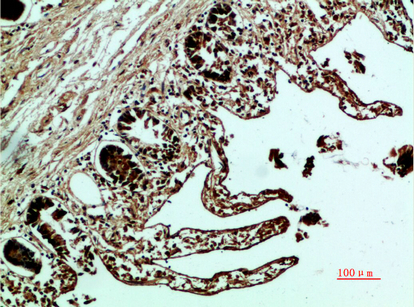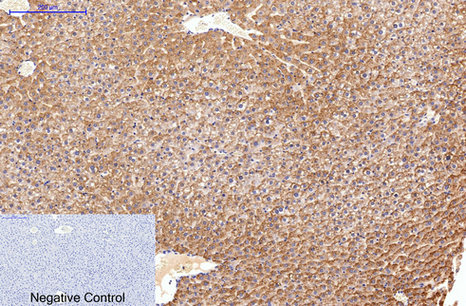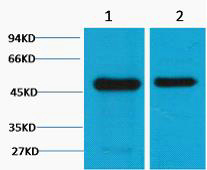Total FN1 Cell-Based Colorimetric ELISA Kit
- Catalog No.:KA3262C
- Applications:ELISA
- Reactivity:Human;Mouse;Rat
- Gene Name:
- FN1
- Human Gene Id:
- 2335
- Human Swiss Prot No:
- P02751
- Mouse Swiss Prot No:
- P11276
- Rat Swiss Prot No:
- P04937
- Storage Stability:
- 2-8°C/6 months
- Other Name:
- Fibronectin (FN) (Cold-insoluble globulin) (CIG) [Cleaved into: Anastellin;Ugl-Y1;Ugl-Y2;Ugl-Y3]
- Detection Method:
- Colorimetric
- Background:
- alternative products:Additional isoforms seem to exist,developmental stage:Ugl-Y1, Ugl-Y2 and Ugl-Y3 are present in the urine from 0 to 17 years of age.,disease:Defects in FN1 are the cause of glomerulopathy with fibronectin deposits type 2 (GFND2) [MIM:601894]; also known as familial glomerular nephritis with fibronectin deposits or fibronectin glomerulopathy. GFND is a genetically heterogeneous autosomal dominant disorder characterized clinically by proteinuria, microscopic hematuria, and hypertension that leads to end-stage renal failure in the second to fifth decade of life.,function:Fibronectins bind cell surfaces and various compounds including collagen, fibrin, heparin, DNA, and actin. Fibronectins are involved in cell adhesion, cell motility, opsonization, wound healing, and maintenance of cell shape. Interaction with TNR mediates inhibition of cell adhesion and neurite outgrowth.,online information:Fibronectin entry,PTM:Forms covalent cross-links mediated by a transglutaminase, such as F13A or TGM2, between a glutamine and the epsilon-amino group of a lysine residue, forming homopolymers and heteropolymers (e.g. fibrinogen-fibronectin, collagen-fibronectin heteropolymers).,PTM:It is not known whether both or only one of Thr-2064 and Thr-2065 are/is glycosylated.,PTM:Sulfated.,similarity:Contains 12 fibronectin type-I domains.,similarity:Contains 16 fibronectin type-III domains.,similarity:Contains 2 fibronectin type-II domains.,subunit:Mostly heterodimers or multimers of alternatively spliced variants, connected by 2 disulfide bonds near the carboxyl ends; to a lesser extent homodimers. Interacts with FBLN1, AMBP, TNR, LGALS3BP and COL13A1. Interacts with FBLN7.,tissue specificity:Plasma FN (soluble dimeric form) is secreted by hepatocytes. Cellular FN (dimeric or cross-linked multimeric forms), made by fibroblasts, epithelial and other cell types, is deposited as fibrils in the extracellular matrix. Ugl-Y1, Ugl-Y2 and Ugl-Y3 are found in urine.,
- Function:
- cell morphogenesis, cell morphogenesis involved in differentiation, acute inflammatory response, cell motion, defense response, acute-phase response, inflammatory response, cell-substrate junction assembly, cell adhesion, cell-matrix adhesion, regulation of cell shape, response to wounding, cell migration, peptide cross-linking, regulation of cell morphogenesis, biological adhesion, cell-substrate adhesion, cellular component morphogenesis, cell junction assembly, cell junction organization, substrate adhesion-dependent cell spreading, wound healing, cell motility,localization of cell,
- Subcellular Location:
- Secreted, extracellular space, extracellular matrix .
- Expression:
- Expressed in the inner limiting membrane and around blood vessels in the retina (at protein level) (PubMed:29777959). Plasma FN (soluble dimeric form) is secreted by hepatocytes. Cellular FN (dimeric or cross-linked multimeric forms), made by fibroblasts, epithelial and other cell types, is deposited as fibrils in the extracellular matrix. Ugl-Y1, Ugl-Y2 and Ugl-Y3 are found in urine (PubMed:17614963).
- June 19-2018
- WESTERN IMMUNOBLOTTING PROTOCOL
- June 19-2018
- IMMUNOHISTOCHEMISTRY-PARAFFIN PROTOCOL
- June 19-2018
- IMMUNOFLUORESCENCE PROTOCOL
- September 08-2020
- FLOW-CYTOMEYRT-PROTOCOL
- May 20-2022
- Cell-Based ELISA│解您多样本WB检测之困扰
- July 13-2018
- CELL-BASED-ELISA-PROTOCOL-FOR-ACETYL-PROTEIN
- July 13-2018
- CELL-BASED-ELISA-PROTOCOL-FOR-PHOSPHO-PROTEIN
- July 13-2018
- Antibody-FAQs



